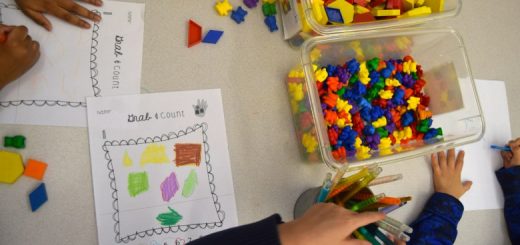‘We’re from the university and we’re here to help’
BRISTOL, Vt. — The mobile home park in this rural village seemed to be hibernating on a subfreezing, snowy day. But there was evidence of damage from an earlier storm that had brought high winds and freezing rain — another in an unusual number of weather events that have battered this state with flooding and other natural disasters.
“It looks like they just had to replace some skirting, probably from the storm,” said Chris Ouellette, property manager for the county, pointing at the plywood wrapped around the base of one home shared by several people she said had recently been homeless. “We have a roof that was ripped off a house over there. We’ve had a couple sheds that have been lost.”
At least one of the residents had started a GoFundMe page to pay for repairs, Ouellette said. “There’s no funding that is designated in any way for mobile home parks,” she said, before trailing off. “So when you have a situation like these storms that continue to keep coming …”
Now help is arriving from an unexpected source: The University of Vermont, or UVM, the state’s flagship higher education institution, has opened a new center to help rural communities like this one. Among other projects, it has taken on the long-neglected job of finding ways to make this kind of mobile home park more resistant to extreme weather.

Supporting their neighbors isn’t always a priority for universities and colleges. Even when it is, it often happens so quietly that it isn’t widely noticed.
“It’s not on the national radar,” said Glenda Gillaspy, dean of the College of Agricultural and Life Sciences at the University of Wisconsin-Madison, which is upgrading and expanding a network of weather and environmental monitoring stations crucial to that state’s farmers and foresters.
But advocates suggest that such help is one way to counteract crashing public confidence in higher education, a problem that has been worsened by political attacks and self-destructive missteps by even the most elite universities.
Related: More universities and colleges reach out to boost their home communities
Universities that engage in community outreach “are that middle piece in between what the community needs and this political thing,” Gillaspy said.
This kind of work pulls faculty, students and researchers away from grand, picturesque campuses with neat grassy quads like UVM’s and into neighborhoods like Bristol’s mobile home park, 30 miles away and a world apart, where people can be surprised to see them.
“When you’re knocking on people’s doors and saying, ‘Hi, I’m a student from the University of Vermont,’ people would look at you a little perplexed at first,” said Kelly Hamshaw, a research lecturer in the university’s Department of Community Development and Applied Economics, who is working on the disaster resilience project.

Even before the culture wars and the recent resignations of the presidents of Harvard and the University of Pennsylvania following their performances before a congressional committee and disclosures of plagiarism, Americans’ faith in higher education had dropped more than their confidence in any other institution tracked by the Gallup polling organization, including the presidency, Congress, big business and the criminal justice system.
“There’s huge mistrust between universities and communities, so there is a whole process of culture shift and rebuilding that needs to happen,” said Sarah McKinley, director of community wealth-building programs for The Democracy Collaborative, which encourages universities to leverage some of their $702 billion a year in direct spending and nearly 4 million employees to boost their neighborhoods.
Helping solve community problems is a step toward restoring public confidence, she said. “Whether there’s been a conscious articulation or awareness of that within universities, I don’t know, but there is certainly something to it.”
And not just in rural areas. Through the Greater University Circle Initiative, for example, Case Western Reserve University and several nearby hospitals — more than half of whose neighbors in East Cleveland live in poverty — have agreed to leverage their purchasing power by buying locally and hiring local residents.
Of 100 urban universities surveyed by the Institute for Advanced Studies in Culture at the University of Virginia, three-quarters included public service as part of their missions.
Related: MIT, Yale and other elite colleges are finally reaching out to rural students
Some appear to be acting from self-interest.
For one thing, universities are increasingly fending off calls to pay more taxes on the property they own and on their endowments. Showing communities that they’re contributing in other ways can help deflect those kinds of demands.
Some have also been struggling to attract students and faculty to remote places, inner cities and other areas in economic decline by helping to transform them, “rather than put up walls and be surrounded by a sort of deteriorating urban wasteland,” said Democracy Collaborative President Joe Guinan.
Such interventions can “help stabilize and develop local communities in a way that makes them more attractive places for faculty, for students, to come,” said Guinan. “It’s very much in [universities’] interest to do a thing they should be doing anyway.”

Colby College in Maine, for instance, is helping to revitalize its surrounding city of Waterville, which was hammered by the closing of several manufacturing plants that provided well-paying jobs. The college built a dorm on the main street to help restore foot traffic to the fading downtown, where it has also seeded $200 million worth of projects including an arts center and boutique hotel.
“The people we’re attracting have lots of choices about where they can go and where they can live,” said David Greene, Colby’s president. By helping the community stay vibrant, he said, “you have a much better chance of being able to recruit them to your college.”
Unlike private companies, universities are place-bound, said McKinley. “They aren’t going to pick up and leave. There is that economic stickiness, whether they like it or not.”
Yet “by no means is higher education doing everything it can,” said Bobbie Laur, president of Campus Compact, a coalition of 500 colleges and universities that have committed to serving their communities. It “has a more critical role than it has ever had to make an impact. We should say that it’s an expectation.”
Related: Columbia and N.Y.U. would lose $327 million in tax breaks under proposal
Making that sort of an impact isn’t always smooth, however. Parachuting in to offer solutions to communities’ problems — as in, “We’re from the university, and we’re here to help” — can come across as paternalistic, especially in the current political climate, people who do this work acknowledged.
“A certain amount of humility is absolutely required in almost any of those situations, and universities haven’t been terribly good at humility in the past,” said Kirk Dombrowski, vice president for research and economic development at UVM, who oversees its new Leahy Institute for Rural Partnerships and other community engagement projects.
“We have names for it, right? The ‘town-gown’ dynamic,” said Dombrowski, a cultural anthropologist. “The university sat on a hill and was full of people with big robes and funny hats.”
That perception “has always been kind of true,” he said as bundled-up students just outside his window scurried across the campus of historic red-brick buildings. “And it’s also been not true.” Universities like his were started largely to train teachers for the local schools, for instance, and farmers how to use new and more effective techniques.
Today, Dombrowski said, “Showing that large institutions like this are interested in what’s happening in towns can show goodwill.”
UVM has branched into a multitude of projects through the Leahy Institute, which is named for former Sen. Patrick Leahy and being funded by the same four-year federal grant that is paying for the outreach in Wisconsin and work at Auburn University in Alabama to support chicken farmers, the forest-products industry and the estimated 210,000 jobs they represent in that state.
The institute helped the Town Hall Theater in the town of Middlebury to apply for grants to build a $7.5 million addition, for example, researching such things as the economic impact of the arts in the surrounding county and the number of jobs they represent — a complex task the small nonprofit community theater couldn’t have afforded to do on its own.

“It would have been a tremendous struggle for us to understand what that impact is, or even to have the basic data to be able to craft our narrative,” said Lisa Mitchell, executive director of the theater, which has since raised much of the money that it needs and has begun construction. “This was really game-changing for us.”
Upstairs in the building, a landmark in the heart of town that dates to 1884, performers were rehearsing for an upcoming musical, “Next to Normal,” accompanied on a piano. Downstairs in a gallery was an exhibition of art by a retired local veterinarian.
Related: Culture wars on campus start to affect students’ choices for college
Getting things like free data and statistics might not seem glamorous, but “it’s a wonderful service that we would each have to pay a lot of money for” without the university, said Fred Kenney, executive director of the Addison County Economic Development Corporation, who connected Mitchell with UVM and who also relies on the university for data. “It’s not the only example, but it’s a really useful one.”


As for what’s in it for UVM, he said in a conference room hung with photos of industrial buildings, maps and a framed invitation to the opening of a microbrewery, the theater’s leaders are “letting a lot of people know that they won some grants” and giving some of the credit to the university. “So the word is getting out.”
University employees, of course, are also almost always members of the communities around their campuses. That’s how Hamshaw got involved with another project: making recommendations about a local teen center called the Hub, in rural Bristol, where she lives.
“We intersected on a dog walk actually,” Hamshaw said of the director of the center, Taylor Welch-Plante. The result was a research project conducted largely by students on how Vermont towns are helping and failing their young people.
Related: Experts predicted dozens of colleges would close in 2023 – and they were right
“It’s a really great place to kind of get that information in one quick dose,” said Hamshaw of the teen center, in a former bingo hall across a ballfield from the trailer park and filled with musical instruments, TVs, beanbag chairs and other mismatched furniture, board games, an air-hockey table, art supplies and a disco ball. There’s a skate park outside.
Another benefit: exposing local high school students to their only slightly older college counterparts, helping overcome growing reluctance among rural young people to continue their educations. “The teens can then see the college kids and be, like, ‘Wow, I want to go to college,’ ” Welch-Plante said.

But more people than teenagers, theater lovers and mobile home park residents should be hearing about these community outreach initiatives, said Emma Spett, engagement initiatives coordinator at the Leahy Institute.
“I feel like we’re doing a lot of doing and not a lot of telling,” Spett said.
When a community does see and hear about these good works, it “can completely change the tone” of how the public perceives its local college or university, said Greene, at Colby.
“Colleges and universities have been losing the trust of the public, and there’s no doubt that a piece of this is that they often seem more apart from their communities than a part of their communities,” Greene said. That “can lead to a real distrust of the institutions — that the institutions are not for me, they’re for someone else.”
When he first arrived on campus, he said, “I just felt enormous distrust in the community about Colby and how we seemed to ignore the challenges the city was facing. Now we can have discussions in the city that are completely productive, without having that piece that we don’t trust each other.”
Gillaspy cited the example in Wisconsin of a collaboration with Native Americans by university scientists — one a Native American himself — to return to traditional farming practices while growing particular types of corn.
Projects like those have several advantages, she said. “There’s economic impact. There’s the exchange of ideas and knowledge. And then there’s the people part of it — that confidence and trust.”
This story about college community outreach was produced by The Hechinger Report, a nonprofit, independent news organization focused on inequality and innovation in education. Sign up for our higher education newsletter. Listen to our higher education podcast.





